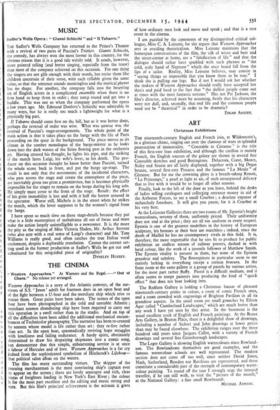ART
Christmas Exhibitions
THE nineteenth-century English and French join, at Wildenstein's, in a glorious chime, ringing out over the clamour of wars in splendid protestation of immortality. "Constable to C.ezanne " is the title of this first-rate loan exhibition, and although the carillon is mainly French, the English sources of the galaxy are shown in several fine Constable sketches and good Boningtons. Delacroix, Corot, Monet, Sisley and Seurat are all fairly displayed, together with a big Degas bronze, several first-rate Pissaros and the famous "La Meule " of Cezanne. But for me the crowning glory is a breath-taking Renoir, "Le Printemps," a pearl as light as air, of such unsurpassed delicacy that to live with it would be to forget all other seasons.
Finally, look to the left of the door as you leave, behind the desks of ladies selling catalogues and collecting entrance money in aid of the Airborne Forces, to see a small Courbet ; a desolate expanse of melancholy foreshore. It will give you pause, for it is Courbet at his very best.
At the Leicester Galleries there are two rooms of Mr. Epstein's bright watercolours, seventy of them, uniformly priced. Their uniformity does not end at the price ; they are all too uniform in every respect. Epstein is one of the greatest modellers in the history of European sculpture, his bronzes at their best are matchless ; indeed, since the death of Maillol he has no contemporary rivals in this field. It is, therefore, the more regrettable that he sees fit to produce for public exhibition an endless stream of railway posters, dashed in with lurid colour, like the work of a juvenile follower of Matthew Smith. The Epstein vitality is present in them, but none of the Epstein grandeur and subtlety. The flowerpieces in particular seem to me entirely lacking in everything except a certain bravura. In the front room at the same gallery is a group of pastels by various artists, for the most part rather fluffy. Pastel is a difficult medium, and it often seems to tempt painters into producing the kind of "quick effect" that does not bear looking into.
The Redfern Gallery is holding a Christmas bazaar of pleasant nineteenth-century prints in colour, a room of comic French ones, and a room crowded with engravings of Brighton Pavilion in all its grandiose aspects. In the small room are small gouaches by Eileen Agar called "Cumberland Landscapes," which are much better than any work I have yet seen by this artist. In the basement is the usual excellent stock of English and French paintings. At the Beaux Arts Gallery, in Bruton Place, there is a delightful show of drawings, including a number of Sickert and John drawings at lower prices than may be found elsewhere. The exhibition ranges over the three hundred odd years since Jacques Callot, with a variety of French drawings and several fine Gainsborough landscapes.
The Leger Gallery is showing English watercolours since Rowland- son. The Rowlandsons themselves are good examples, and the famous watercolour schools are well represented. The modern section does not come off too well, since neither David Jones, Nash, Sutherland, Bawden nor Ravilious are represented, and these constitute a considerable part of the strength of contemporary water- colour painting. To round off the tour I strongly urge the intrepid traveller, if he can still walk, to visit the "picture of the month," at the National Gallery : a fine small Rembrandt.
MICHAEL AYRTON.


























 Previous page
Previous page